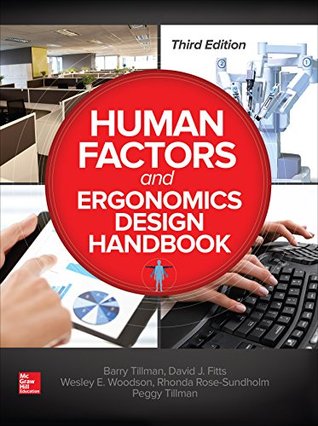Read online Human Factors and Ergonomics Design Handbook, Third Edition - Barry Tillman file in ePub
Related searches:
Human factors and ergonomics - Wikipedia
Human Factors and Ergonomics Design Handbook, Third Edition
Human Factors and Ergonomics Design Handbook - Amazon.com
People-centred designing: 7 Ergonomics and human factors
Human Factors and Ergonomics in Consumer Product Design
Human Factors and Ergonomics Design Principles and Guidelines
The Difference Between Human Factors and Ergonomics
Chapter 1: Ergonomics and Wellness (ergonomics and human
Human Factors and Ergonomics in the Design of Health
HFES Human Factors and Ergonomics Society
Ergonomics and Design A Reference Guide
Handbook of Human Factors and Ergonomics (4th Edition) - Knovel
Human Factors and Ergonomics in Manufacturing & Service
1. Human Factors and Ergonomics Design Technology
Human Factors and Ergonomics DP Design - IB Recap
Human Factors and Ergonomics module : University of Sussex
Proceedings of the Human Factors and Ergonomics Society 39th
Human factors and ergonomics in home care: Current concerns and
(PDF) HUMAN FACTORS AND ERGONOMICS - ResearchGate
Chapter 1: Ergonomics and Wellness (ergonomics/human factors
Human factors and ergonomics - SlideShare
Ergonomics 101: The Definition, Domains, and Applications of
Top 15 Master's in Human Factors and Ergonomics 2020
Buy Ergonomics in Design: Methods and Techniques (Human
International Journal of Human Factors and Ergonomics (IJHFE
[PDF] Ergonomics and human factors: the paradigms for science
Human factors and ergonomics as a patient safety practice
(PDF) Human Factors Engineering and Ergonomics Jonathan
The international ergonomics association defines ergonomics as, “the scientific discipline concerned with the understanding of interactions among humans and other elements of a system, and the profession that applies theory, principles, data, and methods to design in order to optimize human well-being and overall system performance.
Ergonomics and human factors: the paradigms for science, engineering, design, technology and management of human-compatible systems.
Membership in the chapter is open to all individuals interested in human factors, ergonomics, and related fields.
Ergonomic factors have a huge influence over employees’ working behaviour, health and wellbeing. When businesses make decisions with these human factors in mind, it ensures that they are meeting the needs of all their workers and keeping people safe and free of risk.
In - buy ergonomics in design: methods and techniques (human factors and ergonomics) book online at best prices in india on amazon.
Binnen de faculteit industrieel ontwerpen aan de tu delft ben ik werkzaam als associate professor bij de vakgroep applied ergonomics and design.
Ergonomics (or human factors) is the scientific discipline concerned with the understanding of interactions among humans and other elements of a system, and the profession that applies theory, principles, data and methods to design in order to optimize human well-being and overall system performance.
Human factors/ergonomics allows me to pursue my interest in understanding people, but in a practical way that improves the lives of others; integrating the best of people with the best of technology.
The field of human factors and ergonomics is essentially the study of human abilities and limitations to design systems, machines, tools, and organizations that are safe and efficient to maximize human performance and efficiency.
Human factors and ergonomics (generally known as human factors) is the use of mental and physiological.
Ijhfe publishes high quality international interdisciplinary peer-reviewed manuscripts covering ergonomics and human factors in the design, planning,.
Human factors and ergonomics in the design of health information technology: trends and progress in 2014 the application of hfe in the design and implementation of hit remains limited, and the impact of incorporating hfe principles on patient safety is understudied.
What are human factors? human factors (aka comfort design, functional design, user-friendly systems) is the combination of ergonomics and anthropometrics.
The field of ergonomics (also known as human factors engineering) is the systematic study of human capabilities, limitations and requirements, and the application.
Known also as usability engineering, cognitive ergonomics, or user-centered design, human factors is a marriage of psychology and engineering: the application.
This module provides a foundation of principles for human-centred design that will be relevant throughout your degree programme.
Human factors and ergonomics design handbook, third edition master the art of user-centric planning and design.
Written by a team of experts, human factors and ergonomics design handbook, third edition, shows how to maximize functionality while reducing injuries and minimizing the impact on physical and psychological health. The ubiquitous use of smartphones, tablets, and other high-tech equipment is discussed in full detail.
The fourth edition of the handbook has been completely revised and updated.
11 aug 2018 creating a design principle or guideline is not an easy task. They must meet many characteristics to be considered valid, useful and easily used.
Over the last 50 years, ergonomics/ human factors (hfe) discipline has been evolving as a distinctive area of knowledge focusing on the nature of human– artefa.
The space age created new human factors for consideration, including weightlessness and extreme gravitational forces. The information age inspired a closer look at the human-computer interface and workspace design as the personal computer popularized. The benefits provided from the principles of ergonomics and human factors expand to many.
In this definition, ergonomics is the profession that applies theory, principles, data and design methods to optimize human well-being and the overall performance of a system.
In accordance with ergonomics in design: the quarterly of human factors applications' editorial policy, review content is not publicly displayed on publons.
6 jan 2021 designing tasks, equipment and work stations to suit the user can reduce human error, accidents and ill-health.
Ergonomics (or human factors) is the scientific discipline concerned with the understanding of interactions among humans and other elements of a system, and the profession that applies theory, principles, data and methods to design in order to optimize human well-being and overall system performance (definition adopted by the international ergonomics association in 2000).
(1995): questionnaire design and use: a primer for practitioners.

Post Your Comments: